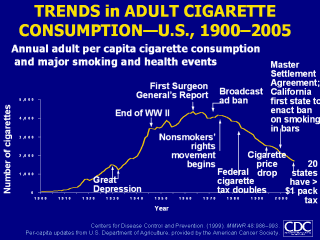| front |1 |2 |3 |4 |5 |6 |7 |8 |9 |10 |11 |12 |13 |14 |15 |16 |17 |18 |19 |20 |21 |22 |23 |24 |25 |26 |27 |28 |29 |30 |31 |32 |33 |34 |35 |36 |37 |38 |review |
 |
Early in the 20th century, several events
coincided that contributed to increases in annual per-capita cigarette
consumption, including the introduction of blends and curing processes that
allowed the inhalation of tobacco, the invention of the safety match,
improvements in mass production, transportation that permitted widespread
distribution of cigarettes, and the use of mass media advertising to promote
cigarettes (USDHHS, 1995). Cigarette smoking among women began to increase in the 1920s, when targeted industry marketing and social changes reflecting the liberalization of women's roles and behavior led to the increasing acceptability of smoking among women (USDHHS,1980; Waldron, 1991). Annual per-capita cigarette consumption by adults (i.e., 18 years or older) increased dramatically from 54 cigarettes in 1900 to a peak of 4,345 cigarettes in 1963 (CDC, 1994). For the year 2005, per-capita consumption was estimated at 1,716 cigarettes per person, a 3% drop from 1,791 in 2004 (USDA, 2006). Some decreases correlate with events such as the first research suggesting a link between smoking and cancer in the 1950s, the 1964 Surgeon General’s Report, and increased tobacco taxation and industry price increases during the 1980s. In 1998, the year of the Master Settlement Agreement, California was the first state to enact a ban on smoking in bars. By the end of 2006, more than 20 states had a tax of at least $1.00 per pack on cigarettes. Centers for Disease Control and Prevention (CDC). (1994). Surveillance for selected tobacco-use behaviors—United States, 1900–1994. MMWR 43 (no. SS-3). U.S. Department of Agriculture (USDA), Economic Research Service. (2006, April 28). Tobacco Outlook. Report TBS-260. Retrieved December 31, 2006, from http://usda.mannlib.cornell.edu/reports/erssor/specialty/tbs-bb/2006/tbs260.pdf U.S. Department of Health and Human Services (USDHHS). (1995). For a Healthy Nation: Returns on Investment in Public Health. Atlanta, GA: Public Health Service, Office of Disease Prevention and Health Promotion and CDC. U.S. Department of Health and Human Services. (1980). The Health Consequences of Smoking for Women. A Report of the Surgeon General. Washington, DC: Public Health Service, Office on Smoking and Health. Waldron I. (1991). Patterns and causes of gender differences in smoking. Soc Sci Med 32:989–1005. |